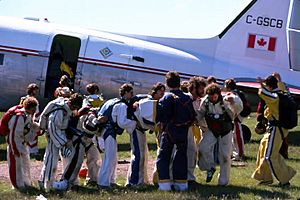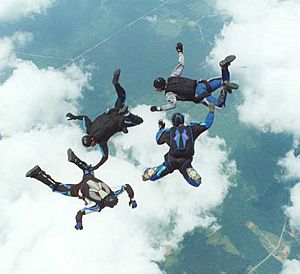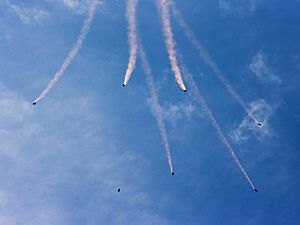Formation skydiving facts for kids

Formation skydiving is an exciting skydiving sport. It's all about skydivers joining together in the air. They hold onto each other's arms, legs, or special "grippers" on their suits. The main goal is to create cool shapes and patterns while falling through the sky.
Contents
Types of Formation Skydiving
Formation skydiving has different types, named after how many people are in a team:
- 4-way sequential: Four skydivers work together.
- 4-way vertical sequential (VFS): Four skydivers make shapes while flying in different positions, like head-down or sitting.
- 8-way sequential: Eight skydivers form patterns.
- 16-way sequential: Sixteen skydivers create large formations.
- 10-way speed: Ten skydivers focus on building formations as fast as possible.
- Large formations (Big-ways): Many skydivers (sometimes hundreds!) join to make huge shapes.
How Competitions Work
In a 4-way formation skydiving competition, teams try to build as many shapes as they can. They have a set time limit, usually 35 seconds.
There are two main kinds of shapes:
- Randoms: These are single shapes. Skydivers must completely let go of each other before and after making the shape.
- Blocks: These are two shapes connected by a special move in between. This move is called an "inter."
Here are some examples of "inters" (the moves between shapes):
- Inter 1: Some skydivers let go and split into two pairs. Both pairs then turn 270 degrees and join back into a new shape.
- Inter 2: Three skydivers stay connected and spin around. The fourth skydiver flies alone during this part.
- Inter 15: Everyone lets go and does a full 360-degree turn. Then, they all connect back into the first shape.
Random shapes are worth one point. Blocks are worth two points because they involve two shapes. There are 16 different random shapes and 22 different blocks.
A competition usually has up to 10 rounds. In each round, teams get a list of 5 or 6 shapes to build. They repeat these shapes as many times as they can in 35 seconds. Judges watch videos of the dives to score them.
The team with the most points at the end wins! If there are problems like bad weather, a competition is still valid if all teams have finished at least one round.
A newer type of formation skydiving is vertical formation skydiving (VFS). In VFS, skydivers create formations using faster body positions. This includes flying head-down or sitting in the air.
Amazing World Records
- Biggest Formation (BIG-WAY)
The largest free-fall formation ever made involved 400 skydivers! This amazing record was set on February 8, 2006, in Udon Thani, Thailand. The group, called the World Team, held the formation for 4.3 seconds. They used five large C-130 Hercules airplanes and jumped from very high up, at 25,400 feet.
In 2013, the World Team tried to break the record for the largest 2-point formation. This means 222 skydivers would form one shape, break apart, and then form a completely different shape. They tried many times and came very close, but didn't quite make it.
- Most Shapes in One Round
- 4-Way: The Belgian team, NMP-PCH Hayabusa, set a record in 2018. They made 62 shapes in just 35 seconds!
- 8-Way: The U.S. national team, Golden Knights, set a record in 2015. They made 33 shapes in 50 seconds!
World Championship History
This table shows the winners of the Formation Skydiving World Championships over the years. You can see which countries won gold medals in different categories.
| Year | Venue | Airplane | 4-Way Champion | Points (avg) | 8-Way Champion | Points (avg) | 4-Way Female Champion | Points (avg) | 4-Way Vertical Formation | Points (avg) |
|---|---|---|---|---|---|---|---|---|---|---|
| 1975 | Warendorf |
40/49.92* | 100/163.85* | Not Held | Not Held | |||||
| 1977 | Gatton, Queensland |
73 (7.3) | 42 (4.2) | Not Held | Not Held | |||||
| 1979 | Châteauroux |
82 (8.2) | 66 (6.6) | Not Held | Not Held | |||||
| 1981 | Zephyrhills, Florida |
116 (11.6) | 83 (8.3) | Not Held | Not Held | |||||
| 1983 | Sun City, North West |
115 (11.5) | 102 (10.2) | Not Held | Not Held | |||||
| 1985 | Mali Lošinj |
118 (11.8) | 120 (12.0) | Not Held | Not Held | |||||
| 1987 | Foz do Iguacu |
134 (13.4) | 119 (13.2) (9 rd) | Not Held | Not Held | |||||
| 1989 | Gerona |
152 (15.2) | 138 (13.8) | Not Held | Not Held | |||||
| 1991 | Lučenec |
Mil Mi-8 | 171 (17.1) | 181 (18.1) | Not Held | Not Held | ||||
| 1993 | Eloy, Arizona |
DHC-6 Twin Otter | 195 (19.5) | 169 (16.9) | Not Held | Not Held | ||||
| 1995 | Gap, Hautes-Alpes |
Pilatus PC-6 Porter | 207 (20.7) | 195 (19.5) | Not Held | Not Held | ||||
| 1997 | Efes |
CASA C-212 Aviocar | 210 (21.0) | 224 (22.4) | Not Held | Not Held | ||||
| 1999 | Corowa |
DHC-6 Twin Otter | 208 (20.8) | 211 (21.1) | Not Held | Not Held | ||||
| 2001 | Granada |
CASA C-212 Aviocar | 214 (21.4) | 193 (19.3) | 147 (14.7) | Not Held | ||||
| 2003 | Gap, Hautes-Alpes |
Pilatus PC-6 Porter | 229 (22.9) | 221 (20.9) (11 rd) | 165 (16.5) | Not Held | ||||
| 2004 | Rijeka |
Mil Mi-8 | 227 (22.7) | 172 (19.1) (9 rd) | 169 (16.9) | Not Held | ||||
| 2006 | Gera |
DHC-6 Twin Otter | 117 (23.4) (5 rd) | 123 (20.5) (6 rd) | 95 (19.0) (5 rd) | Not Held | ||||
| 2008 | Maubeuge |
Pilatus PC-6 Porter | 195 (24.4) (8 rd) | 151 (21.6) (7 rd) | 120 (20.0) (6 rd) | Not Held | ||||
| 2010 | Menzelinsk |
L-410 Turbolet | 277 (27.7) | 203 (20.3) | 236 (23.6) | Not Held | ||||
| 2012 | Dubai |
DHC-6 Twin Otter | 279 (27.9) | 229 (22.9) | 207 (20.7) | 185 (23,1) (8 rd) | ||||
| 2014 | Prostějov |
L-410 Turbolet | 264 (26.4) | 216 (21.6) | 214 (21.4) | 179 (22,4) (8 rd) | ||||
| 2016 | Chicago |
DHC-6 Twin Otter | 262 (26.2) | 239 (23.9) | 224 (22.4) | 168 (22.4) (8 rd) | ||||
| 2018 | Gold Coast, Queensland |
Cessna 208 Caravan | 279 (27.9) | 224 (22,4) | 257 (25,7) | 217 (21,7) | ||||
| 2020 (2021) |
Kemerovo region |
L-410 Turbolet | 193 (32,2) (6 rd) | 166 (23,7) (7 rd) | 150 (25,0) (6 rd) | 143 (20,4) (7 rd) | ||||
| 2022 | Eloy, Arizona |
DHC-6 Twin Otter | 261 228 219 |
205 164 131 |
200 189 184 |
212 190 140 |
See also
- Canopy formation



